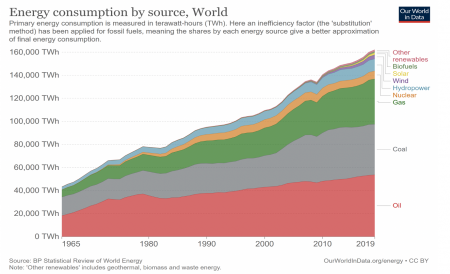Sustainability and climate change will become game changers – shortly
Author: Dr. David Novak (PhD), Engerode 56, D 30880 Laatzen, Germany, david.novak1@t-online.de
Abstract
Purpose: Status regarding climate change and needed activities - The 2015 Paris Agreement was the first global climate conference to set binding targets that must be implemented. Climate change must be combated globally, based on the UN guidelines on the sustainability triangle and the 17 goals. The necessary changes in technologies will affect everyone, regardless of whether they are business (including SMEs there), society / politics and climate protection / sustainability. In the energy sector (production, distribution and application) in particular, massive changes will have to be made as part of the imperative to decarbonize.
Design / methodology / approach: The goal was to write a short report on the status quo in the area of sustainability and anthropogenic climate change and also to add a vision of how it could look like today and possibly at the end of the 21st century based on the current state of knowledge.
Findings: Climate protection and sustainability will increasingly have to be implemented and lived, which is particularly challenging for young people. The energy sector will therefore have to go through the greatest transformation in a necessarily short time that has ever happened. The energy strategies of the future, based on decarbonization, will have to realign themselves with new energy sources such as hydrogen H2 and their new generation countries with sun and wind.
Affected countries: Numerous countries, which are offered these geographical opportunities, become winners in the new competition for income from energy generation, largely paid for by industrialized countries that lack enough free space for wind and solar energy. Emerging and developing countries that are still poor today are opening up unimagined opportunities for high income from hard currencies.
Research / Future / Practical Implications: Visions based on the coming energy transition can be derived from this. It will be by far the largest investment in an industry in a short period of time that can probably only be paid for and controlled by the World Bank and the central banks. It will be a gigantic and expensive challenge for everyone involved (state, economy, population). Not to do so would become even more expensive in the long term, not to mention the catastrophic effects, specifically also on humanity. So if we don't have a choice - let's go for it!
Originality / value: There is currently very little scientific and even less empirical literature on this entire area. Nevertheless, or precisely because of the massive time pressure imposed by politics and for humanity worldwide, it has to be written and reported on scientifically.
Key words: Climate change, sustainability, renewable energies, hydrogen H2, decarbonization.
JEL codes: Q01, Q42, Q49, Q54, Q56, Q57.
1. Introduction
Today's time at the beginning of the 2020s is significantly shaped by the ever increasing, largely anthropogenic, climate change. Is this a problem? Yes, it is, because ultimately it is about nothing other than the survival of global humanity. But it does not seem insoluble, because this climate change is largely man-made, which, conversely, means that man-made behavior can also solve this challenge. That this challenge is huge, precisely because it affects the entire world does not need to be discussed further, because it is obvious. The solutions will probably not be less people and less consumption, probably only to a limited extent a changed behavior of people (that can only be changed over long periods of time and is generally not particularly popular), but through better and, above all, different technology and a different awareness in the behavior of each individual.
2. Sustainability in general, shown on the model of 7 pillars
Sustainability is defined in a relatively general way worldwide by the UN and rests on an isosceles triangle or on three equally high pillars (Purvis, B. et al, UNO): Environment, Society and Economy. All three areas are equally large or equally important. This general model was then further developed as the 17 sustainability goals in the 2030 Agenda (UNO), and the scientist Hamid Doost Mohammadian expanded it as the 7 pillars (7 Ps model). This is made up of:

Figure 1: Doost Mohammadian, H.: The 7 pillars. Source: FHM Homepage
This model is also a kind of vision for a better world with a high level of education for all those involved and at the same time social and environmentally conscious action. It is based on the economic sector of the SMEs, but ultimately affects the entire economy and society. Since social and ecological issues are included, it corresponds to the original equilibrium model of the UN for sustainability.
To what extent this model will prevail or implement as part of the 5th industrial revolution (term in Germany), as a fifth wave (Doost, 2010-2017) or as Made in China 2025 (term in China), or when and where too Whenever it becomes part of the possible reality, it cannot and should not be judged here because it is too big a separate topic. The implementation of new findings in new technologies and then also in new products may happen faster than ever, perhaps also spurred on by the corona virus. In this regard, the SMEs will have to react faster than ever in order to keep up with global trends. In the area of climate protection, it can be assumed that it will be in any case. Technological breakthroughs will (have to) go hand in hand with an upheaval in laws and jurisdiction. On the other hand, this creates significant new business areas, expressly also for SMEs, in which, according to marketing theory, however, the pioneers and not the laggards in the cycle will participate significantly.
3. Sustainability from the perspective of the 2020s, focus on climate protection
As mentioned in the introduction, the world now seems to finally understand the inevitable importance of global climate protection. At least most of the political leaders and most of the managers in companies too. Still, late but still. The importance of conferences like Paris 2015 (European Commission) or now coming Glasgow 2021 is growing steadily and is accepted, at least in semi-developed countries. Climate protection will be the dominant topic of the 21st century. Unless the rising temperatures are permanently limited to an acceptable level, the direct consequences are likely to be dire and the indirect consequences may be even worse. From this point of view, the associated challenge of financing climate protection measures or investing in green energies appears to be a rather small problem, which, however, also has to be solved. In any case, sustainability and the systematic and global fight against anthropogenic climate change is not the private property of organizations like Greenpeace, or global campaigns like Fridays For Future. Even if it sounds problematic for serious scientists: Those who are significantly concerned about the future and thus about the containment of climate change are precisely those who still have the future ahead of them, because for them the future is most important: the young People. And who is the main leader of companies and states: They are mainly old men who simply do not have a long future ahead of them simply because of their older age (Maheshwari, V. 2020). Therefore, the shortened representation: Young people (pro climate protection immediately) against old men (rather traditional energy sources such as coal, oil and gas - and if possible not aiming for changes), at least in essence, not wrong. Obviously a sociological problem as well.
4. Energy situation worldwide, transformation in the energy sector
Despite the knowledge that consumption is too high, expressly also in the energy sector (first publicly realized in the groundbreaking and revolutionary book "The Limits to Growth" 1972, Meadows D. et al), the world's hunger for energy has continued to increase. The necessary restriction in behavior when using primarily non-regenerative resources, which was already propagated at that time, has practically not been recognized or implemented worldwide. It was not until the Paris Agreement in 2015 that, after various steps such as the Brundtland Report 1986 and the conferences in Rio 1992, as well as the Kyoto Protocol 1996, the world community made a binding commitment that clear goals must be achieved by clear deadlines, if the climate (and that would affect the whole earth) should not completely overturn. The Earth-Overshoot-Day (Global Footprint Network), developed as a mathematically-based scientific model by W. Rees and M. Wackernagel (the author is in direct contact with both of them), shows that despite all assurances and tentative efforts by politicians (and in part certainly also of the economy and the population), this day continues from December 31st. removes the fact that mankind constantly consumes more than what nature can cope with through the self-healing powers. In 2021 it was July 29th. Of course, this model is not only focused on the energy sector, but on all consumption, but also includes the energy sector. And the progress made so far is more than manageable.
5. Energy strategies for the future
It is always very difficult to make forecasts because they concern the future. Therefore, the predictions can only be very vague. However, some core theses can be made based on the state of the art today, all of which will run under the heading of decarbonization (carbon-based products must be replaced). These include: 1. The general focus on regenerative energy sources, mainly wind and sun in electricity generation, as well as 2. The promotion and increased use of heat pumps (which extract heat from the environment in order to heat buildings). Possibly there is also a 3. effect, namely away from large, central energy producers (large power plants) towards small, decentralized energy producers up to the size for individual houses. This effect has the advantage that there are practically no losses whatsoever during the transfer of energy, since the energy is consumed right where it is produced.
In any case, the goal must be that the production and emission of greenhouse gases of all kinds, mainly CO2, are de facto excluded, regardless of the type of use of the energy carrier.
5.1. Energy strategies by industrialized countries
In industrialized countries, due to their technical leadership, the focus will certainly always be on continuously improved technologies, e.g. to further improve efficiency, reduce the required energy consumption (devices are becoming more and more economical), generally further develop existing systems (innovation), or even completely new developments to achieve (invention). Whether and - if so - when a permanent and possibly massive reduction in the required primary energy will be achieved cannot be reliably assessed. Relevant progress has not really been made, at least in terms of overall energy consumption per se, at least not so far.

Figure 2: World Energy Consumption by source, 1965 - 2019. Source: Ritchie, Roser.
In any case, however, new products such as green H2 (or ammonia, methanol or other carrier substances for H2) from industrialized countries will (have to) be imported to a large extent, mainly from windy and sunny countries with their simultaneously low population density, as their own The amount of electricity to be produced, especially if it is to be regenerative, will not be sufficient for this energy source in decades. In addition, in most industrialized countries there is simply not enough free space to designate huge and necessary areas for wind and solar energy. The dependency on energy imports will therefore remain, but it will probably be much lower than it is now. At the same time, it will be able to control various technical areas abroad in energy generation, since this technology will probably come mainly from the industrialized countries.
The extent to which electricity from nuclear energy will be used (which is now completely unthinkable in Germany, but a matter of course in other industrialized countries, which French President Macron expressly reiterated in October 2021) cannot be estimated. The states that will not use nuclear energy need feasible alternatives (keyword: base load capacity), those with nuclear energy will have to deal solely with the permanent disposal / storage of the spent core elements. But at least nuclear energy does not generate any relevant amounts of CO2 (can therefore be seen as a contribution to decarbonization), so that this form of energy could possibly even be classified as “green” by the EU in Brussels in the future, which is currently still completely open.
5.2 Energy strategies through sunny and / or windy countries
It may sound like a fairy tale to many - and yet it can come true. All countries (usually belonging to the 2nd, 3rd or even 4th world according to the definition of the UN and thus belonging to the poorer, poor or even poorest) could by using the available wind energy (preferably evenly blowing, e.g. in the Argentine Patagonia) and the annual solar irradiation of approx. 3,000 hours as in the Maghreb states of North Africa (Kalman, A., 2007), achieve immense income, at least if they themselves, or multinational corporations, have invested in this renewable energy source in advance. Of course, these countries will have to invest sums (see also 7.) that they have not yet dreamed of. Regardless, they now get the unique chance to come to a "club", as it was previously only OPEC worldwide and that means that the door is pushed open to them to almost immeasurable wealth, namely the majority of energy expenditure from all industrialized countries in the world. Certainly there will then be more states than at OPEC, on the other hand, every state that has to import energy will come into question as a buyer. In this case, sustainability is lived across all three pillars in the 3-pillar model of the UN (Purvis, B. et al, UNO), because not only is green energy generated that was not previously available, but it is being generated earns a lot of money (economy) and it will probably stabilize society at a significantly higher level, because the additional state income (which was not available before) can now also ensure significantly more social justice. At least then, if the often very fragile political conditions do not lead to a further unequal distribution of wealth. However, the emergence of a middle class is becoming more likely, both through the national profits and through new jobs that this energy generation will create there.
5.3 Energy strategies by all other countries
Yes, there will still be countries afterwards that will not be among the winners. Lack of wind and / or solar radiation, the impossibility of building harbors and / or a geographical location so far away from customers that it is not worth investing there. With the new technologies, these countries will become self-sufficient at most (after all, they will save on energy imports), but nothing more. Nevertheless, the savings in energy imports will, at least locally, have certain positive effects, even if these will not be comparable with the energy-exporting countries. Even with the locally active SMEs.
6. Vision energy situation for the end of the 21st century
It is well known that visions are problematic because they look to the future and imagine positive things without having any right to implementation. Nevertheless, from the known, or also written here, deductions for the future can be made as to what an optimal case as a vision could look like (The following assessments are based on the author's existing knowledge and the assessment of developments from a technological, economic and political point of view.):
- The energy used worldwide (electricity, liquids, gases) is basically CO2-neutral (decarbonization), so without exception does not cause any further, at least relevant, CO2 components that get into the ambient air and also no other greenhouse gases such as methane, so that at least over this no further heating of the climate takes place.Assessment: realistic, from 2060.
- Electricity is produced exclusively using renewable energy sources such as wind turbines or photovoltaic systems. Parts of the electricity are stored as green H2 and transported via pipelines or also stored there. Assessment: realistic, from 2060.
- Green H2 is mutating, as it can be easily transported and stored, into the energy source of the 21st century. Alternatively, it can be converted into other products such as ammonia, methanol, etc. for transport. Assessment: realistic, from 2035.
- All emerging and developing countries with a steady amount of wind and / or regular and intense solar radiation will cover their own energy needs in the medium term (that is, they will save billions in hard and little available foreign currency). Economically a huge gain. In addition, they will produce energy in the form of H2, ammonia, methanol or other carrier media and export it via pipelines (rather seldom and rather shorter distances) or via appropriate tankers (probably preferably, rather long distances, especially intercontinental) and thus generate immense income. In principle, any country with these geographic preconditions will be able to get rich like most OPEC countries are today. That is then in any case sustainable, because it can also have very positive effects on social and economic issues. Assessment: partially realistic, from 2060.
- Since a lot of water is required for H2, which is in short supply especially in arid areas, seawater desalination plants will have to be built on the local coasts. The water obtained will be needed for H2. Remaining water can be collected e.g. in pumped storage power plants / reservoirs (if there are hills / mountains) and drained if necessary in order to generate new electricity in a kind of cycle. There the collected water will automatically have a positive effect on the micro-climate (1. Cooling effect during the day, 2. The bank will green itself over time, 3. The water will become animals of all kinds, from microbes to birds attracting mammals, 4. It will be usable as a fish breeding tank and especially 5. As a drinking water reservoir) (Tahmiscioglu, MS et al, 2011). Seawater desalination plants (manufacturers and direct / indirect users) will therefore indirectly win the hydrogen strategy.Assessment: partially realistic, to a larger extent only from 2060.
- These countries will probably export the gaseous or liquid energy via ships, so that they will have to build new ports / port facilities (there will have to be very long quay walls to fill the giant tankers of the new generation), or at least expand existing ones, including huge pipelines and gas / liquid tanks. Assessment: partially realistic, starting from 2035 on a larger scale.
- Since there will probably be a daily world market price for H2, which is listed on the stock exchange, all customers and all suppliers will be treated equally, which leads to equal opportunities. At the same time, it makes it easier for everyone involved to plan. Assessment: realistic, starting from 2035.
- It is possible that heat pumps will also be further developed in such a way that, in addition to emitting heat into the building and only consuming little electricity, they will also be able to use the medium / heat source (air, water and / or soil) at least locally (on a micro scale) to cool down over the years, which is definitely to be welcomed in the course of global warming. In the case of running waters (rivers, sewage) or seas, the cooling effect can have a positive effect, even if only in the immediate micro-environment. Assessment: partially realistic, starting from 2035 on a larger scale.
- SMEs will have opportunities to generate good sales both in the manufacturer countries and in the importing countries. The assumed investments will also benefit the SME to a certain extent, e.g. through the regional / local sale of new "H2-ready" gas burners, as well as assembly, permanent maintenance and the replacement of necessary pipes in de facto all households. In the exporting countries, one will have to take care of the renewable energies and of course also the conversion into H2. Millions of new jobs, expressly also at SMEs, can and will be the result. Assessment: absolutely realistic, starting from 2030.
7. Financing the global energy transition
Of course, the financing of the energy transition must also be discussed. Experts suspect that this will be the largest investment in human history for an industry in a very short time. The Federal Association of German Industry sees additional expenditure of gigantic € 860 billion for Germany in the area of climate protection by 2030 alone (deutschlandfunk.de). Even a country like Germany, which is not at the top worldwide in terms of area or population, will certainly have to reckon with several trillion euros, at least if you count everything “all in”. In Germany, projections indicate that the domestic costs alone for the entire energy transition could be at the level of the costs for reunification, and that the state alone amounted to € 2 trillion (Schäfers, 2021). Extrapolated for the world, an amount of € or $ 100 trillion is not unrealistic. As a global challenge for mankind, this financing must be financed or subsidized, e.g. via the World Bank, via the very large central banks such as the Fed, ECB etc. and via a kind of fund (The World Bank). A large field that needs to be dealt with separately. It must be clear, however, that independent financing by poorer countries is generally excluded. In addition, all energy suppliers involved, which are often multinational corporations, must be made responsible for international investments of gigantic proportions.
8. Conclusion (theses)
- Sustainability as a term is clearly defined by the UN and by scientists like Hamid Doost (7 pillars). You just have to work on it all over the world.
- The global and current climate agreements make those responsible today (politicians, managers) obliged to act proactively. If one wants and has to align human behavior to the future, then one also has to listen to young people, to whom the future belongs to a large extent, and perhaps less to old people, who may tend to keep what has been past than to themselves Open to something new.
- Due to anthropogenic climate change, the reduction of climate-damaging emissions (mainly CO2, decarbonization) is absolutely imperative and non-negotiable. The global energy sector is most affected.
- There are probably 3 trends in energy supply: 1. Focus on regenerative energy sources such as wind and sun, which produce other energy sources such as green H2. 2. Massive expansion of the use of heat pumps. 3. Reduction of the previous central, towards the more decentralized (local, regional, national) and also globally distributed energy production.
- In the future, industrialized countries will continue to have to import energy, preferably green H2, which they obtain from countries that are geographically favorable for production using renewable energies.
- All countries that are geographically favorable (wind, sun, open space, seaports) can become energy export nations and generate undreamt-of profits in the future.
- In the future, the energy export nations will, at least partially, be able to build up a level of power (economically and politically) comparable to that of the OPEC states today.
- Developing countries with below-average geographical conditions will at least be able to generate energy for themselves, which will massively reduce their expenditure on energy imports.
- The positive visions for the energy situation at the end of the 21st century can realistically be achieved, if the responsible decision-makers actually participate proactively and recognize and implement the opportunities as a whole.
- SMEs will be able to participate in the energy transition in all countries of the world, make profits and create jobs to a considerable extent, provided they adapt to the new technologies (wind energy, photovoltaics, hydrogen H2, heat pumps) in good time.
- Probably additionally required and newly built seawater desalination plants will cause various positive side effects locally with intelligent use, so that climate change counteracts locally (micro-environment) and has a positive influence on flora, fauna and people.
- The UN / World Bank and the central banks must finance the energy transition towards greenhouse gas neutrality in the long term (many decades).
- Understand that limiting the global rise in temperature and thus saving the global climate is a question of the existential importance of global humanity and not a temporary fashionable topic from self-proclaimed global kickers from western industrialized nations.
9. References
Doost Mohammadian, H. (2020.10.30.). New concept for SMEs. Retrieved from: https://www.fh-mittelstand.de/news/artikel/fhm-lecturer-prof-dr-dr-hc-hamid-doost-mohammadian-introduces-new-concept-for-smes-3046. Retrieved at: 2021.10.14.
Europäische Kommission, Homepage. Übereinkommen von Paris. Retrieved from: https://ec.europa.eu/clima/eu-action/international-action-climate-change/climate-negotiations/paris-agreement_de. Retrieved at: 2021.10.08.
Kalman, A. (2007). Partner für Energie. Abgerufen von: https://www.deutschlandfunk.de/partner-fuer-energie.716.de.html?dram:article_id=90392. Abgerufen am: 2021.10.05.
Meadows, D. et al (1972). Club of Rome. Limits to Growth. Retrieved from: https://www.clubofrome.org/publication/the-limits-to-growth/. Retrieved at: 2021.10.10.
Purvis, B. et al. (based on UNO). Three pillars of sustainability. Retrieved from: https://link.springer.com/article/10.1007/s11625-018-0627-5. Retrieved at: 2021.10.08.
Rees, W., Wackernagel, M., (no Date). Global Footprint Network, Homepage, Earth Overshoot Day. Retrieved from:http://www.footprintnetwork.org/de/index.php/GFN/page/earth_overshoot_day/. Retrieved at: 2021.10.13.
Ritchie, H., Roser, M. (2020) - "Energy". Published online at OurWorldInData.org. Retrieved from: 'https://ourworldindata.org/energy'. Retrieved at: 2021.10.10.
Ritchie, H., Roser, M. (2020). Energy (in: Our World in Data). Retrieved from: https://ourworldindata.org/energy. Retrieved at: 21.10.08.
Schäfers, H., rtl.de (2021.09.29.). Umbau auf erneuerbare Energie wird so teuer wie die Wiedervereinigung. Retrieved from: https://www.rtl.de/cms/energiewende-bedeutet-hohe-kosten-fuer-umbau-auf-erneuerbare-energien-4839057.html. Retrieved at: 2021.10.04.
Tahmiscioglu, M.S. et al. (2011). POSITIVE AND NEGATIVE IMPACTS OF DAMS ON THE ENVIRONMENT. Retrieved from: https://cvc.ca/wp-content/uploads/2011/02/60.pdf. Retrieved: 2021.10.14.
The World Bank. Homepage (2021.09.23.). World Bank Launches Initiative to Issue USD 10 Billion in Sustainable Development Bonds while Highlighting the Urgency of Mainstreaming Climate Action. Retrieved from: https://www.worldbank.org/en/news/press-release/2021/09/23/world-bank-launches-initiative-to-issue-usd-10-billion-in-sustainable-development-bonds-while-highlighting-the-urgency-o. Retrieved at: 2021.10.12.
UNO. Homepage (no Date). The 17 goals. Retrieved from: https://sdgs.un.org/goals. Retrieved at: 2021.10.08.
W. A., Deutschlandfunk Homepage (2021.10.22.). Für Klimaziele 2030 Mehrinvestitionen von 860 Milliarden nötig. Retrieved from: https://www.deutschlandfunk.de/studie-fuer-klimaziele-2030-mehrinvestitionen-von-860.2850.de.html?drn:news_id=1314073. Retrieved at: 2021.10.27.
10. List of figures
Figure 1: Doost Mohammadian, H.: The 7 pillars
Figure 2: World Energy Consumption by source, 1965 - 2019. Source: Ritchie, H., Roser, M..


